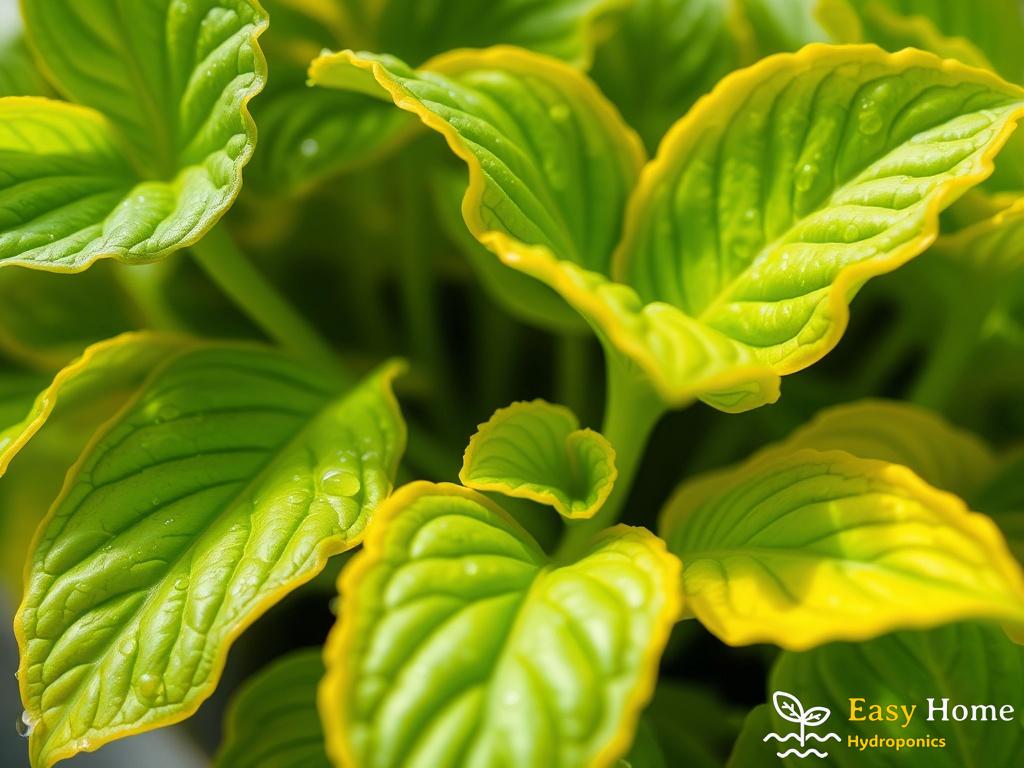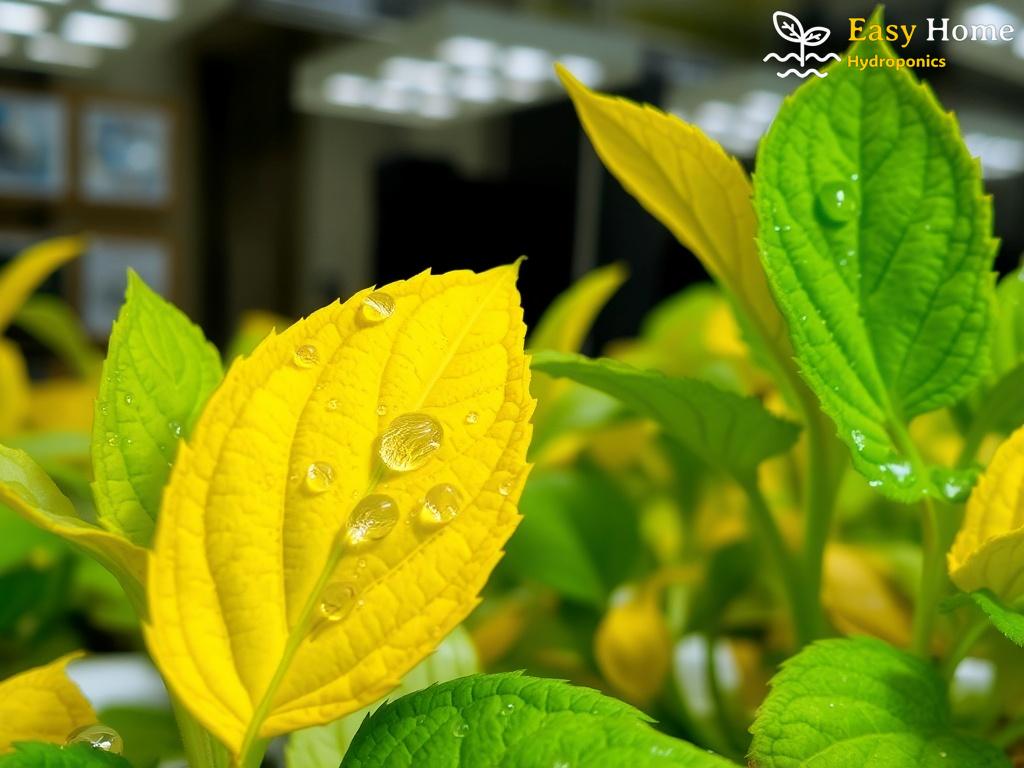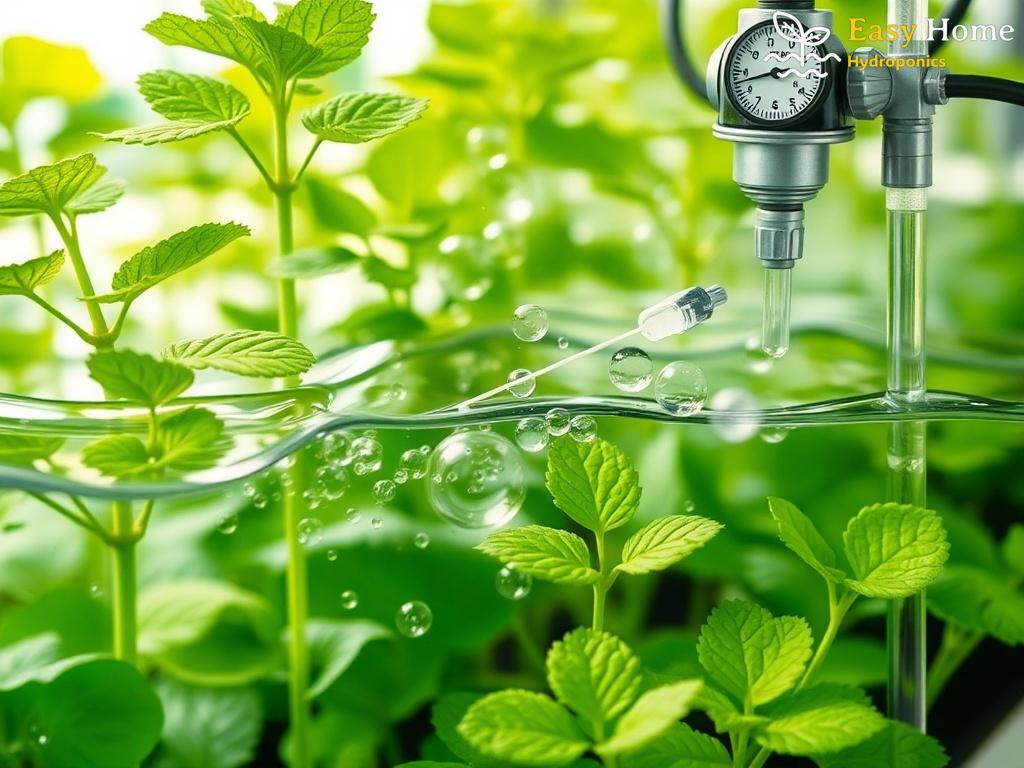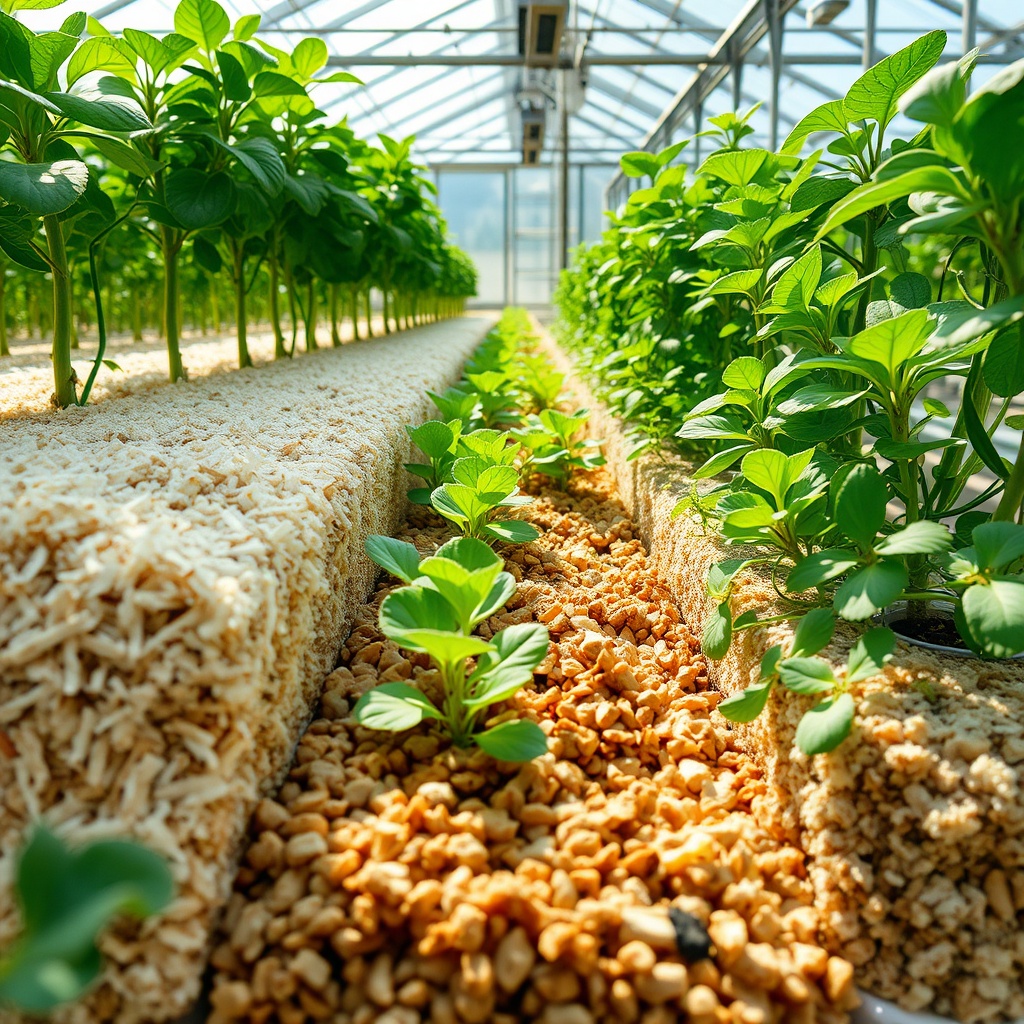The Science Behind Leaf Yellowing

In the fascinating world of hydroponics, the color of a plant’s leaves can speak volumes about its health. Leaf yellowing, often perceived as a simple aesthetic issue, is a multifaceted phenomenon that can indicate various underlying conditions. Understanding these signals is crucial for anyone looking to cultivate thriving plants in a hydroponic system.
Chlorosis, the technical term for leaf yellowing, can stem from several causes, each requiring a tailored solution. Let’s explore the primary culprits behind this condition:
- Nutrient Deficiencies: A lack of essential nutrients, particularly nitrogen, iron, and magnesium, can lead to chlorosis as plants struggle to produce chlorophyll.
- pH Imbalance: The pH level of the nutrient solution plays a vital role in nutrient absorption. A pH that is too high or too low can lock out key nutrients, causing leaves to yellow.
- Water Quality: Contaminated or poor-quality water can introduce harmful substances that hinder plant growth and contribute to leaf yellowing.
- Environmental Stress: Factors such as temperature fluctuations, inadequate light, and humidity levels can stress plants, leading to various signs of distress, including yellowing leaves.
To effectively address leaf yellowing, it’s essential to diagnose the problem accurately. Here’s a step-by-step guide to tackle this common issue:
- Observe the Symptoms: Look closely at the leaves. Are the veins remaining green while the tissue turns yellow? This could signal iron deficiency.
- Check Nutrient Levels: Utilize a nutrient testing kit to assess the concentration of essential elements in your hydroponic solution.
- Test pH Levels: Regularly monitor the pH of your nutrient solution to ensure it’s within the optimal range (5.5 to 6.5 for most hydroponic plants).
- Assess Water Quality: Test your water for contaminants and consider using filtered or distilled water if necessary.
By following these steps, you can pinpoint the reason behind your hydroponic plants’ yellowing leaves and take appropriate action to restore their health.
Nutrient Deficiencies: The Hidden Culprits
In hydroponics, the delicate balance of nutrients is the lifeblood of plant health. When this equilibrium is disrupted, plants can exhibit a range of distress signals, with yellowing leaves being one of the most noticeable. This yellowing is not merely an aesthetic concern; it is a clear indicator of nutrient deficiencies lurking beneath the surface. Understanding the specific nutrients that contribute to leaf color can empower growers to take decisive action and maintain vibrant, healthy plants.
Nitrogen is a primary macronutrient essential for plant growth, playing a crucial role in the synthesis of chlorophyll—the green pigment in leaves. A deficiency in nitrogen often manifests as yellowing in older leaves first, as the plant reallocates nitrogen to newer growth. This condition can drastically affect photosynthesis and overall plant vigor. The key is to recognize that while nitrogen is vital, too much can also lead to its own set of problems, including lush foliage at the expense of fruit or flower production.
Iron deficiency is another sneaky culprit behind leaf yellowing, particularly in young leaves where the veins remain green while the areas between them turn a striking yellow. This condition, known as interveinal chlorosis, is often exacerbated by pH imbalances that inhibit iron uptake. Maintaining an optimal pH range can make all the difference in ensuring that iron remains bioavailable to plants. Understanding the unique role of iron in chlorophyll production can help growers make informed adjustments to their nutrient solutions.
| Nutrient | Symptoms of Deficiency | Recommended Action |
|---|---|---|
| Nitrogen | Yellowing of older leaves | Add nitrogen-rich fertilizers or adjust nutrient mix |
| Iron | Interveinal chlorosis in young leaves | Check pH, add chelated iron supplements |
| Magnesium | Yellowing at leaf edges | Introduce magnesium sulfate (Epsom salt) |
By understanding the distinct roles of these nutrients, hydroponic gardeners can better diagnose and remedy issues related to leaf yellowing. Regularly monitoring nutrient levels and adjusting the nutrient solution based on observed symptoms can lead to thriving plants and a bountiful harvest. Recognizing the signs of nutrient deficiencies is an art that, when mastered, can transform the cultivation experience from frustrating to fulfilling.
Environmental Factors Affecting Leaf Color
In the intricate tapestry of hydroponic gardening, environmental factors weave a significant thread that influences leaf color. While nutrient deficiencies often steal the spotlight, environmental stressors can also lead to the alarming sight of yellowing leaves. Understanding these factors is crucial for any hydroponic enthusiast aiming to cultivate robust and vibrant plants. Let’s dive into the environmental elements that can dramatically affect leaf color and overall plant health.
Light serves as the primary energy source for photosynthesis, yet its intensity and duration can profoundly influence leaf color. Insufficient light can trigger chlorosis, as plants struggle to produce the necessary chlorophyll, resulting in pale yellowing leaves. Conversely, too much light can cause stress, leading to leaf burn and a sudden yellowing as the plant attempts to protect itself. Striking a balance is essential; ensuring your plants receive adequate light during their growth cycle can prevent these issues. Consider using adjustable grow lights to maintain optimal light levels, and always monitor your plants’ responses to any changes.
Temperature fluctuations can significantly impact leaf health, often leading to yellowing as plants react to stress. Extreme heat can cause rapid water loss, leading to dehydration and subsequent yellowing of leaves. On the other end of the spectrum, cold temperatures can slow down metabolic processes, inhibiting nutrient uptake and causing chlorosis. It’s vital to maintain a stable temperature range, typically between 68°F to 75°F (20°C to 24°C), for most hydroponic plants. Employing heaters or coolers in your growing area can help regulate temperature and ensure your plants thrive.
| Environmental Factor | Impact on Leaf Color | Recommended Action |
|---|---|---|
| Light | Insufficient light leads to pale yellowing; excessive light causes leaf burn | Adjust light levels based on plant response |
| Temperature | Extreme heat causes dehydration; cold temperatures inhibit nutrient uptake | Maintain stable temperatures between 68°F to 75°F (20°C to 24°C) |
By understanding the delicate interplay between environmental factors and leaf color, hydroponic growers can make informed decisions to mitigate stressors and promote healthier plants. Recognizing that yellowing leaves can signal a range of issues from nutrient deficiencies to environmental stresses empowers growers to take a holistic approach to plant care. With careful observation and timely adjustments, you can cultivate a thriving hydroponic garden that flourishes in vibrant green.
Preventive Measures for Healthy Foliage
In the vibrant world of hydroponics, preventive measures are the cornerstone of a thriving garden. Addressing leaf yellowing before it becomes a pervasive issue not only enhances the aesthetic appeal of your plants but also ensures their overall vigor and productivity. By adopting a proactive approach, growers can create an environment that fosters robust foliage and minimizes the risk of nutrient deficiencies and environmental stressors.
Regular Monitoring: The Key to Early Detection
Establishing a routine for monitoring your hydroponic system can significantly reduce the likelihood of leaf yellowing. Observing your plants daily provides insight into their health and allows for timely interventions. Pay close attention to any changes in leaf color, texture, and growth patterns. This vigilance acts as an early warning system, enabling you to address potential problems before they escalate. Additionally, regularly testing the nutrient solution and pH levels ensures that your plants receive the essential elements they need for optimal growth. A slight adjustment can often be the difference between lush foliage and the distressing sight of yellowing leaves.
Optimizing Nutrient Delivery: A Balanced Approach
To prevent the onset of chlorosis, cultivating a balanced nutrient solution is essential. This involves not only providing the necessary macro and micronutrients but also understanding the unique needs of your specific plants. Utilizing high-quality fertilizers and employing targeted nutrient solutions can help maintain the delicate equilibrium required for healthy foliage. Moreover, incorporating a strategy for nutrient cycling can further enhance nutrient availability, ensuring that plants can access what they need when they need it. With a keen eye on nutrient delivery, you can mitigate deficiencies that lead to yellowing leaves and foster a thriving hydroponic ecosystem.
Creating an Optimal Environment: The Foundation of Health
The environment in which your plants grow plays a pivotal role in preventing leaf yellowing. Factors such as light intensity, humidity, and temperature should be carefully calibrated to meet the specific needs of your plants. Aim for consistency in your growing conditions; fluctuations can lead to stress that manifests in yellowing foliage. For instance, utilizing adjustable grow lights can help tailor the light exposure to your plants’ growth stages, while maintaining a stable temperature range can prevent the adverse effects of heat stress or chilling. By crafting an optimal environment, you are laying the groundwork for robust plant health that resists the temptations of yellowing leaves.
Identifying Plant Stress Signs Early
In the realm of hydroponics, the health of your plants is paramount. However, recognizing when they are under stress can be challenging, especially since plants can be quite subtle in their expressions of distress. Leaf yellowing is often one of the first visible signs, but it is just the tip of the iceberg. By understanding how to spot early indicators of stress, you can take proactive measures to safeguard your beloved plants and ensure their vibrant growth.
Plants, much like humans, exhibit a variety of signs when they are not thriving. These signs can range from minor changes in leaf color to more severe physical symptoms. Delving deeper into the early warning signals can help you address issues before they escalate into serious problems.
To effectively identify plant stress, it is essential to familiarize yourself with the common indicators. Below is a comprehensive list of symptoms that may suggest your hydroponic plants are not at their best:
- Leaf Yellowing: As discussed, yellowing leaves are often the most noticeable sign of nutrient deficiencies or stress.
- Wilting: Leaves may droop or become limp, indicating water stress or root problems.
- Stunted Growth: If your plants are not growing as expected, it may be a sign of inadequate nutrient uptake.
- Discoloration: Besides yellowing, other color changes like browning or spotting can indicate specific nutrient deficiencies or pest issues.
- Leaf Drop: Shedding leaves prematurely can be a response to environmental stressors or nutrient imbalances.
Consistency is key in monitoring your hydroponic plants. By setting up a routine, you can create a framework for early detection of stress signs. Here’s a simple approach:
| Frequency | Observation Focus | Action |
|---|---|---|
| Daily | General health, leaf color, wilting | Adjust light, check water levels |
| Weekly | Nutrient solution levels, pH balance | Test and adjust nutrient mix |
| Monthly | Growth progress, root health | Inspect roots and consider repotting |
By adhering to this observation schedule, you can effectively catch any signs of plant distress early on. Remember, the sooner you identify potential problems, the better equipped you will be to take action and restore your plants to their full glory.




